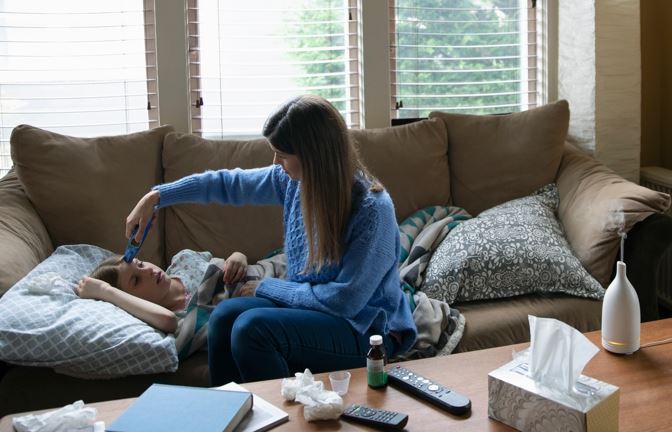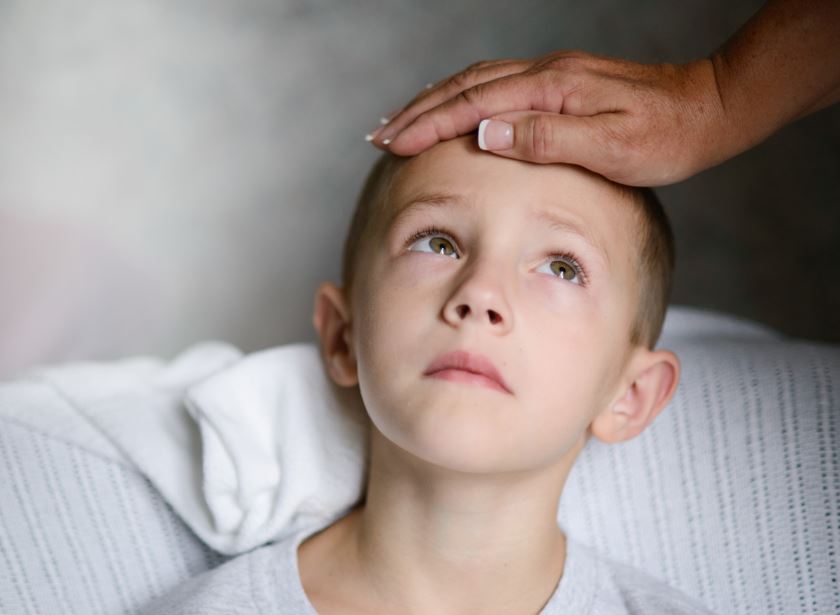To find and book a pediatrician click here.
The weather is cooling down, school’s back in session, which means it’s respiratory virus season! Not to worry, Smarties, we’ve got help. Pediatrician Dr. James Dunville of Novant Waverly Pediatrics and Primary Care has some great recommendations on what parents can look for and what to do if your child gets sick. – Smarty Carroll
Before we get into the common illnesses Dr. James Dunville of Novant Waverly Pediatrics and Primary Care is seeing this time of year, and what to expect, he offers three basic guidelines to keep in mind.
3 Rules of thumb
If your child is 3 or younger:
If your child is sick, just bring them into the doctor unless you know for sure that it’s just a little cold. Younger children are a little bit higher risk, especially young babies, because for the first few months of life, the immune system is still developing.
If your child is older than 3:
When you get older, you can have more of a grace period because older kids and teenagers can articulate better what’s going on. If something is getting worse at home over a period of days, that’s when I typically say “Come on in so we can definitively say what this is.”
When it’s OK to send an ailing child back to school:
I want you to stay out of school until you have these two criteria: 1) fever free for 24 hours and 2) with improving symptoms. Symptoms don’t fully go away. A very common thing with all sorts of viruses is post-viral cough. Truthfully, they’re (often) no longer infectious. They just have some lingering inflammation that causes that cough.

7 Common viruses
Rhinovirus – essentially the common cold.
It’s normally cough, congestion, a little bit of sore throat, sometimes some fever, and not a whole bunch of other symptoms.
Adenovirus – mirrors strep throat.
We don’t want to miss a strep infection because that requires an antibiotic, so we do a test. If it’s strep, we give them the amoxicillin. If it’s not strep, oftentimes it’s adenovirus. It shows up with red eyes, cough, congestion, fever, really bad sore throat, some swollen lymph nodes in your neck, and then you can have some diarrhea or some GI stomach symptoms with it.
This one lasts about a full week and I’ve seen some angrier versions of it. There’s nothing special to do for it. It has to run its course, but it’s important for us to get a strep swab to know that it’s not a strep infection.
RSV – cold symptoms for adults, more serious for babies
The reason it gets so publicized is because when young babies, particularly up through the age of 2 or 3, get that particular virus, it tends to hit their lungs instead of the upper respiratory passages. As a result, they can have instances where they’re breathing faster. You see something called retractions, or belly breathing. You can look at the ribs and see the skin sucking in because they’re having a hard time breathing.
They get a lot of mucus and congestion in the lungs that causes basket breathing, significant coughing. They can get high fevers. Occasionally we have to send young children to the hospital to get extra oxygen and support.
Croup – upper airway virus
This virus is not in the lungs; it’s in the upper airway, the area right above your vocal cords. That area can get very swollen, and that causes of barky cough. But the main thing that we’re looking out for with croup is something called strider, which is noisy breathing on the inhale. That’s super important. If you’re ever noticing your child do that at all, you want to go see your doctor immediately.
Oftentimes we give steroids for croup because that upper airway gets so inflamed and swollen, it can be really hard to breathe. We want to keep that airway open and reduce all that inflammation.
COVID-19 – the latest info
We’re still seeing it in kids, but it’s mostly just showing up as almost allergy symptoms, a little bit of congestion with a sore throat. Oftentimes they don’t even have fever. It’s important since it’s still affecting our adults, for everybody to still get tested.
With a positive test, the CDC is still recommending essentially a five-day quarantine from the start of symptoms. As long as the child is fever free with improving symptoms at that point, they’re fine to go back to school.
I get asked about COVID vaccines a lot, and my answer is I stand by the CDC as far as recommending permanent vaccine vaccination for all kids.
FLU – vaccinations are important
There are two main strains: Flu A and Flu B. Flu A tends to be more severe and with Flu B you can get more of a stomach flu. The important thing to know about flu is we want you to get tested for it because we want to know how much of it is out there in the population. Number 2, if you are tested within the first 24 to 48 hours, and you’re positive, theirs is a medicine called Tamiflu that can knock down about 24 hours of your symptoms.
I am very big on flu vaccination, especially for higher risk patients, which would be kids with asthma and other lung issues.
Stomach bugs
Stomach bugs are shorter, lasting more like 24 hour 48 hours, but some can last up to a week or so. That those can be frustrating. The main thing is to make sure your child is not getting too dehydrated. One of the things we can do is send some nausea medicine, Zofran, to stop some of that vomiting and help keep more hydration on board. Then we just treat the symptoms, rest and have it run its course.
For babies you want at least four wet diapers in a 24-hour period. For older children, it’s are you peeing four times a day and what does the urine look like. Is it super concentrated, yellow and dark? Are you going a small amount?
Novant Health
Healthy Headlines
Facebook
Instagram
Twitter
YouTube




